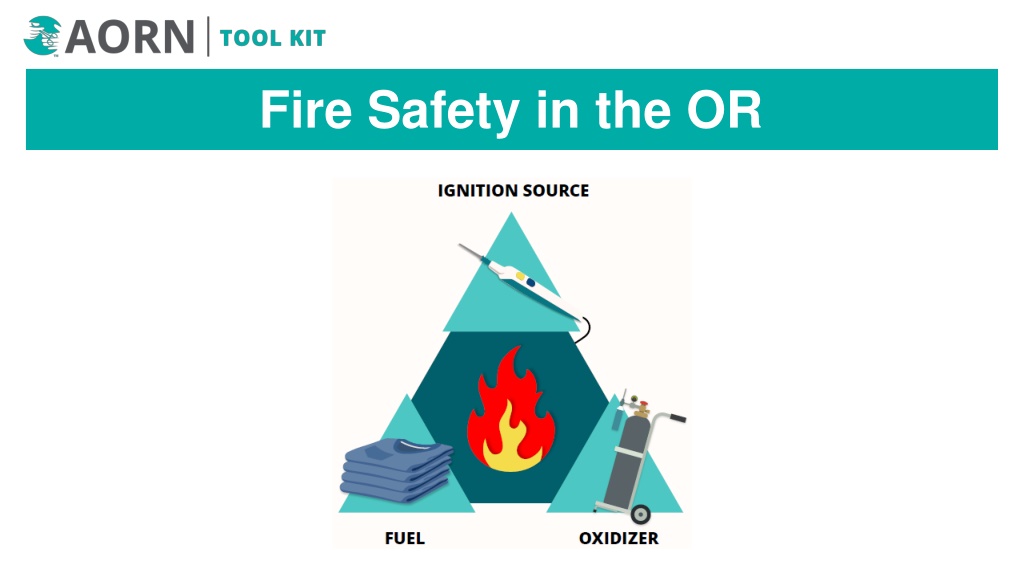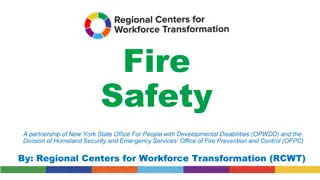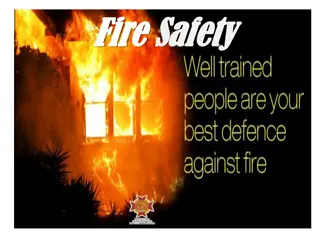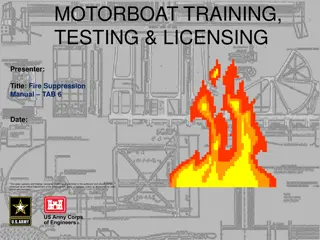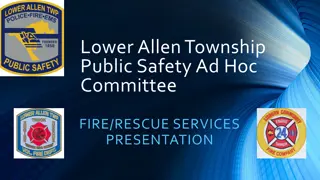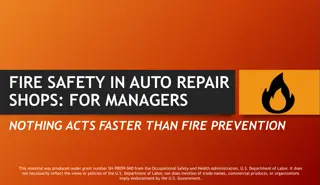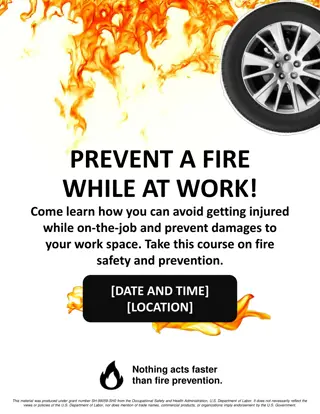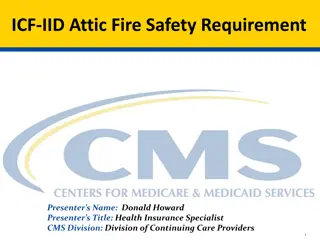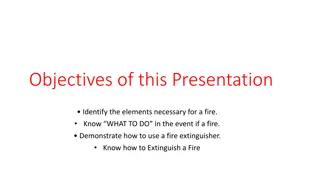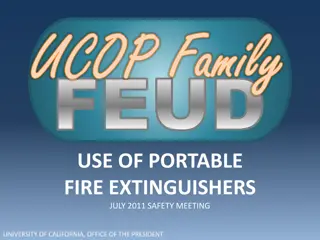Fire Safety in the Operating Room: Prevention and Management
Gain knowledge on preventing and managing fires in the OR to enhance clinical practice. Topics include surgical fire statistics, fire risk assessment, high-risk procedures, ignition sources, and interventions for reducing risks.
Download Presentation

Please find below an Image/Link to download the presentation.
The content on the website is provided AS IS for your information and personal use only. It may not be sold, licensed, or shared on other websites without obtaining consent from the author. Download presentation by click this link. If you encounter any issues during the download, it is possible that the publisher has removed the file from their server.
E N D
Presentation Transcript
Outcome You will gain knowledge of interventions to prevent and manage fires in the OR and transfer this knowledge into clinical practice. Objectives 1. Discuss concepts related to fire safety in the OR. 2. Describe key takeaways to prevent and manage fires in the OR. Fire Safety
Surgical Fires ~90 to 100 per year in the United States 95% are minor 1-2 are fatal
Surgical Fire Sites 44% head, neck, chest 26% on the patient 21% in the airway 8% in the patient Fire Safety
3.2 Fire Prevention Starts with Assessment of Risk As part of the preprocedural briefing process, the perioperative team should initiate a fire risk assessment to assess for the presence of the three elements of the fire triangle. [Recommendation] Fire Safety
High High- -Potential Procedures Potential Procedures Surgical procedures performed above the xiphoid process and in the oropharynx carry the greatest risk: Lesion removal on the head, neck, or face Tonsillectomy Tracheostomy Burr hole surgery Removal of laryngeal papillomas Fire Safety
Fire Risk Assessment Process Before the procedure starts Everyone participates Identify fire risks that are present Intervene based on the risks identified Document assessment and that action was taken Fire Safety
3.2.1, 3.2.2 THERE IS NO FIRE RISK CATEGORY OR SCORE!
Ignition Sources Electrosurgical unit (ESU) Argon beam coagulator Power tools (eg, drills, burrs, saws) Fiberoptic light cords Lasers
Reducing Risks: Ignition Sources Inspect Use safety holsters or protective caps as intended Moisten soft goods used near ignition sources Follow device manufacturer s IFU equipment/devices before use Use lowest possible energy settings Verify availability of water/saline and extinguisher Communicate with team before activating devices Place equipment in standby mode Fire Safety
Oxidizers Oxidizers
Reducing Risks: Oxidizers Verify anesthesia circuit and gas connections are leak-free Configure drapes to prevent accumulation of oxygen Use moistened sponges Minimize use of ignition sources when possible Communicate the presence of an oxygen-enriched environment Communicate with the team before activating devices Anesthesia professional activities Intubate or use laryngeal mask airway if clinically indicated Use tinted solution in the endotracheal tube cuff Reduce oxygen delivery to minimum needed and stop nitrous oxide Flush with medical or ambient air Notify the surgeon when an ignition source can be activated Fire Safety
Fuels Surgical drapes Patient Linens Sponges Dressings Alcohol-based skin antiseptic Endotracheal tubes Surgical attire Bone cement Fire Safety
Reducing Risks: Fuels Implement Implement safe practices when using alcohol-based skin antiseptics Cover Cover hair with water-soluble gel to cover hair Use Use water-based ophthalmic ointment in the eyes Moisten Moisten soft goods used near the surgical site Fire Safety
3.4.2, 3.4.3 Alcohol-based Skin Antiseptics Prevent pooling by placing sterile or clean towelsnear the surgical preparation site to absorb drips and excess solution, using sterile towels to absorb excess solutionfrom the prepped skin surfaceor for drying if indicated, removing materials that become wet with the skin antiseptic agent before draping the patient, and moving solution-soaked materials away from ignition sources and outside of the patient care vicinity (ie, 6 ft away) Follow the skin antiseptic manufacturer s IFU for recommended minimum dry time and allow the agent to dry completely before draping
Managing Fires In vs. on the patient Patient vs. non-patient (eg, equipment) Airway vs. non-airway Fire Safety
Using a Solution to Extinguish a Fire Use a nonflammable liquid such as saline or water. Aim at the base of the fire. Remember: drapes may be impermeable. Fire Safety
How to Smother a Fire Hold towel between the fire and the patient s airway. Drop the end of the towel closest to the patient s head. Drop the other end of the towel over the fire. Sweep hand over the towel from the patient s head toward their feet. DO NOT PAT. Raise the towel. Keep your body away from the fire. Fire Safety
Do not use fire blankets in the OR! Fire Safety
NFPA* Fire Classification Class A: wood, paper, cloth, and most plastics (eg, combustible materials) Class B: flammable liquids or grease Class C: energized electrical equipment Combination: ABC, AC * NFPA = National Fire Protection Association Fire Safety
Fire Extinguisher Selection Select according to the local authority having jurisdiction Conflicting guidance NFPA recommends water mist or carbon dioxide ECRI recommends only carbon dioxide [Facility-specific] extinguishers are available in the ORs at [facility name]. Fire Safety
Using a Fire Extinguisher Remember PASS P Pull the pin. A Aim the nozzle at the base of the fire. S Squeeze the handle. S Sweep the stream over the base of the fire.
Perioperative RNs Surgical technologists Surgeons Anesthesia professionals Assistants Environmental Services Quality/Risk Personnel Administrators Fire Prevention and Fire Prevention and Management is a Management is a Team Effort Team Effort Fire Safety
Team Responsibilities in a Fire Depends on: Personnel present o Facility o Time of day Size of the fire Location of the fire Fire Safety
Personnel Anesthesia professional RN circulator Scrub person Supervising physicians Surgeon Assistants Support personnel Charge RN Administrator Fire Safety
Surgical Fire Locations Ambulatory surgery centers Hospitals Physicians offices Fire Safety
Time of Day Normal business hours Evenings Weekends On-call hours Fire Safety
Fire Size and Location Airway vs. non-airway Patient vs. non-patient (eg, equipment) Small vs. large Fire Safety
Responsibilities: All Fires Alert team members to the fire Smother or extinguish the fire Push the instrument table away Remove burning material Stop the flow of airway gases Assess the patient for injuries Notify appropriate personnel Act as a liaison to patient s family Assess for secondary fires Notify the fire department Retain involved materials and supplies Document the event Fire Safety
Responsibilities: Large Patient Fire Shut off the oxygen supply to the room Smother or extinguish burning materials Activate the fire alarm system Notify appropriate personnel Delegate roles for non-direct caregivers Direct traffic Fire Safety
Responsibilities: Airway Fire Remove the endotracheal tube from the airway Remove any burning materials from the airway Disconnect and remove the breathing circuit Re-establish the airway and resume ventilation Pour saline into the airway Examine the airway Fire Safety
Responsibilities: Equipment Fire Shut off the electricity to the equipment if unable to disconnect from outlet Remove the working end of the equipment from the sterile field Disconnect equipment from power source Shut off gases to the equipment, if applicable Remove equipment from the OR, if possible Evacuate OR if necessary Fire Safety
Responsibilities: OR Evacuation Assist with the decision to evacuate Order evacuation of the surrounding area Order evacuation of the OR Compile a list of people in the perioperative area Communicate the need to evacuate Activate the disaster plan Fire Safety
Evacuation Types and Areas Horizontal or vertical evacuation Fire doors Smoke compartments Evacuation floor plan maps Fire Safety
Evacuation Procedure: Remember to RACE R Rescue A Alarm/Alert C Confine/Contain E Evacuate Fire Safety
Contacting the Fire Department Know How the fire department is notified When (eg, every fire event) Who is responsible for notifying Fire Safety
The Local Authority Having Jurisdiction May assist with perioperative education programs Determine types of fire extinguishers Determine dispenser location and amount of alcohol-based hand hygiene product that can be stored Fire Safety
References Surgical Fire Prevention. ECRI. Accessed December 8, 2023. https://www.ecri.org/solutions/accident-forensic-investigation-services/surgical-fire- prevention Surgical Fire Data. ECRI. 2009. Updated 2017. Surgical Fires. ECRI. 2016. https://www.ecri.org/components/HRC/Pages/SafSec13_1.aspx Wright R. Guideline for a Safe Environment of Care. Kyle E, ed. eGuidelines+ ed. Association of periOperative Registered Nurses (AORN), Inc.; 2023. Culp Jr. WC, Kimbrough BA, Luna S. Flammability of surgical drapes and materials in varying concentrations of oxygen. Anesthesiology. 2013;119(4):770-776. Fire Safety
